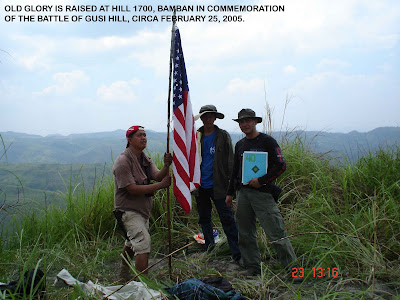


















 Ohnishi Shrine is dedicated to the airmen and aircrews of both the Amnericans and Japanese who died in air battle during WWII. The area was used to be the headquarters of Admiral Takijirio Ohnishi of the Japanese First Air Fleet and later of the Combined Naval Air Forces commanded by Admiral Fukutome; from November 1944 to January 11, 1945. It was researched by Rhonie Dela Cruz as to the authenticity of historical data and provided by aide of Ohnishi, Mr. Moji Chikanori, formerly a commander in rank in the Japanese Navy. The two tunnels, the headquarters of Ohnishi and Fukutome and the Communication Tunnel were located and identified. Lighting were provided and an exhibit was established inside the tunnels. The shrine is maintained by Mr. Dionisio Manipon who owns the land where the site is located.
Ohnishi Shrine is dedicated to the airmen and aircrews of both the Amnericans and Japanese who died in air battle during WWII. The area was used to be the headquarters of Admiral Takijirio Ohnishi of the Japanese First Air Fleet and later of the Combined Naval Air Forces commanded by Admiral Fukutome; from November 1944 to January 11, 1945. It was researched by Rhonie Dela Cruz as to the authenticity of historical data and provided by aide of Ohnishi, Mr. Moji Chikanori, formerly a commander in rank in the Japanese Navy. The two tunnels, the headquarters of Ohnishi and Fukutome and the Communication Tunnel were located and identified. Lighting were provided and an exhibit was established inside the tunnels. The shrine is maintained by Mr. Dionisio Manipon who owns the land where the site is located.







 Japanese delegation for World Peace Program held their annual ceremony at the Bamban Airfield Memorial in Barrio Virgen Delos Remedios on October 25, 2001 with the BHS members, visitors, and local officials. Bhuddist Bishop Ekap Ikeguchi led the Japanese delegates. Bamban Airfield was one of the airfield component of Clark Air Center that was largely utilized by the Japanese 4th Air Army and the 1st and 2nd Air Fleet of the Navy in 1942-1945. It was also used as staging based of the special attack forces (kamikaze) of Air Group 206, 653 and Air Regiment 72 & 73. The last kamikaze sortie take-off was at Bamban Airfield on January 13, 1945 from the Air Regiment 73. The Japanese prayed for the repose of souls of all the Filipinos, Americans, and Japanese soldiers and airmen who died in Bamban during WWII.
Japanese delegation for World Peace Program held their annual ceremony at the Bamban Airfield Memorial in Barrio Virgen Delos Remedios on October 25, 2001 with the BHS members, visitors, and local officials. Bhuddist Bishop Ekap Ikeguchi led the Japanese delegates. Bamban Airfield was one of the airfield component of Clark Air Center that was largely utilized by the Japanese 4th Air Army and the 1st and 2nd Air Fleet of the Navy in 1942-1945. It was also used as staging based of the special attack forces (kamikaze) of Air Group 206, 653 and Air Regiment 72 & 73. The last kamikaze sortie take-off was at Bamban Airfield on January 13, 1945 from the Air Regiment 73. The Japanese prayed for the repose of souls of all the Filipinos, Americans, and Japanese soldiers and airmen who died in Bamban during WWII.


 Students from International School located in Taguig City participated in the ICARE program aimed at helping recipients like the BHS Bamban Museum of History maintain and develop the museum in 2006. There were more than 40 students who participated in a three-day activities. Aside from the museum, the students from IS also participated in cleaning and clearing of memorials and markers
Students from International School located in Taguig City participated in the ICARE program aimed at helping recipients like the BHS Bamban Museum of History maintain and develop the museum in 2006. There were more than 40 students who participated in a three-day activities. Aside from the museum, the students from IS also participated in cleaning and clearing of memorials and markers


 BHS activities related to the US commemoration of Memorial and Veterans Day in 2006. Also, BHS donated the photo frame of the Flag Raising at Hill 1700 (taken by the US Army 40th Div Signal Company during the battle of Hill 1700 at Gusi Hill, Bamban on February 25, 1945). The photo is now in the display inside the US Embassy in Manila. It was donated on May 27, 2005.
BHS activities related to the US commemoration of Memorial and Veterans Day in 2006. Also, BHS donated the photo frame of the Flag Raising at Hill 1700 (taken by the US Army 40th Div Signal Company during the battle of Hill 1700 at Gusi Hill, Bamban on February 25, 1945). The photo is now in the display inside the US Embassy in Manila. It was donated on May 27, 2005.
This is the story of how the Bamban Historical Society was established and its important accomplishment in its almost ten years of existence.
